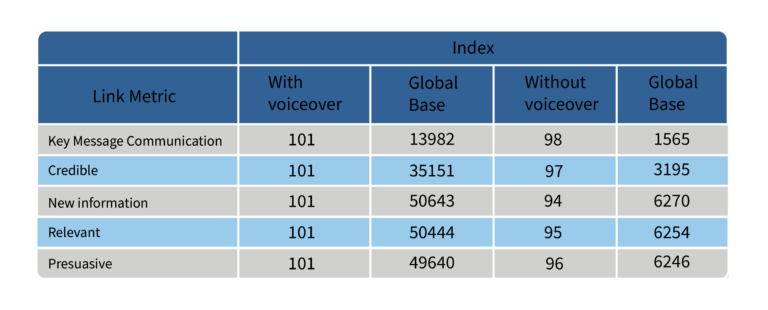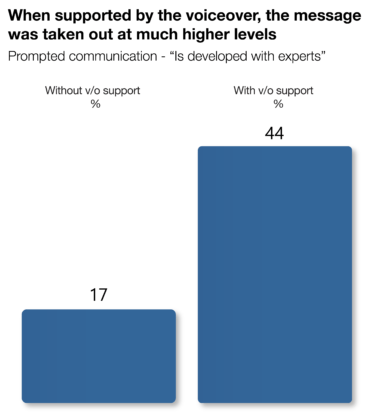
Psychology Confirms: Voice-over Makes Your Ads More Memorable
Are you a Branding & Communication Manager? A Creative Producer working on a commercial multimedia campaign? Or a localization project in a media agency? If so, we know all about that blood, sweat, and tears translated in hours of cross-team collaboration, countless edits, and some hundreds of thousands of dollars. And now that your commercial content is ready, you are carefully crafting the campaign strategy for different target markets.
How will your message resonate with different target groups?
Let’s be honest; you don’t have the time – or budget – for experimentation. You need a fast solution that your budget can afford and bring maximum results. But you understand the power of video and the need for impactful content localization.
Yes, subtitles are fast and cheap, however, you already know the answer: voice-over is the best localization technique so the audience enjoys a complete, uninterrupted video experience, as it should.
Stats and Facts
Many suggest that, when it comes to mobile run campaigns, you must go “sound-off”. But this is only partially true. Actually, 60% of US YouTube users watch Ads with sound-on, with the UK reaching 65% in the same category. Which makes sound an important ad feature. Ads with real human voices can work miracles and are proved to achieve more than sound-off campaigns. Here is why:
1. Higher Credibility Levels
Recent customer research has proved that “Ads with voice-overs score slightly but consistently higher than Ads without voice-overs”. A voice that creates trust is a significant benefit. Verbalizing your call-to-action encourages potential customers to the next step, to take the action you are guiding them to.
2. Lift Brand Awareness and Ad Recall

The power of real human voices in advertising is so immense that YouTube has launched audio-only Ads on a global level. Since different people use YouTube differently, voice-only Ads are a great tactic to approach users based on different consumer behaviors. The results justified this attempt:
- 75% of audio Ads campaigns drove a significant lift in brand awareness
- “ […]purchases consideration among interested shoppers, driving above benchmark lifts of 14 percent lift in ad recall and 2 percent lift in favorability among their target audience” as revealed by early Shutterfly in audio Ads to influence purchase consideration.
3. Enjoyment and Engagement
Discounts on quality or experience can result in low engagement and enjoyment rates. Choosing subtitles means you’re forcing your audience to concentrate as much as possible to understand the message. Just think of all the viewers that happened to briefly look away, missing a whole sentence of your carefully crafted script. How possible is it to keep them engaged?
4. Attracts attention
During ad breaks, people may become distracted. This makes catching their attention fundamental, and – either you like it or not – you only have a few seconds to do so. So, you need to use all the tools in your toolbox.
Verbalized product descriptions or even a verbalized call-to-action (especially including highly impactful words like “today” or “now”) in Ads voice-overs can attract attention and enhance engagement.
5. Screen limited space.
There are two basic limits in most subtitling cases:
- a 32-characters limit per line
- two lines on-screen limit at a given time
This means that “real estate” on your screen is very little and precious. Extensive use of text on-screen forces viewers to switch between viewing and reading distracting them from screen action. This makes the experience hard to follow and hardly remembered.
6. Brand humanization
A real human voice with a personality and tone of voice aligned with the brand will make your audience feel spoken to and represented. This way, you can boost brand metrics and bring long-term benefits like developing consumer’s consideration and purchase intent by boosting Front-of-mind Awareness.
7. Who-Says-What
When your video is based on a dialogue between two or more actors, subtitles may confuse your audience (especially when they have little or no knowledge of the original language).
Who can remember something that was poorly understood? Who can follow a dialogue when “who-says-what” is not clear?
8. Oral Language Tools
Pauses, silences, accents, puns are some oral language tools that add to the enjoyment of an Ad. Pauses and silences are used to add emphasis or as surprise elements. Accents can also be used to add fun, enjoyable elements when used playfully. Voice-overs maintain these subtle messages and communicate directly to the hearts and minds of viewers.
If you’re localizing your videos and you’re juggling a tight deadline and budget, no worries! We got you covered and can beat your deadline at the best price.
Contact for free our team, and within a few hours, you’ll get professional advice and a quote.
In need of voice-over services?
We provide high-quality voice-overs.

Anna Sticken
Key Account Manager
